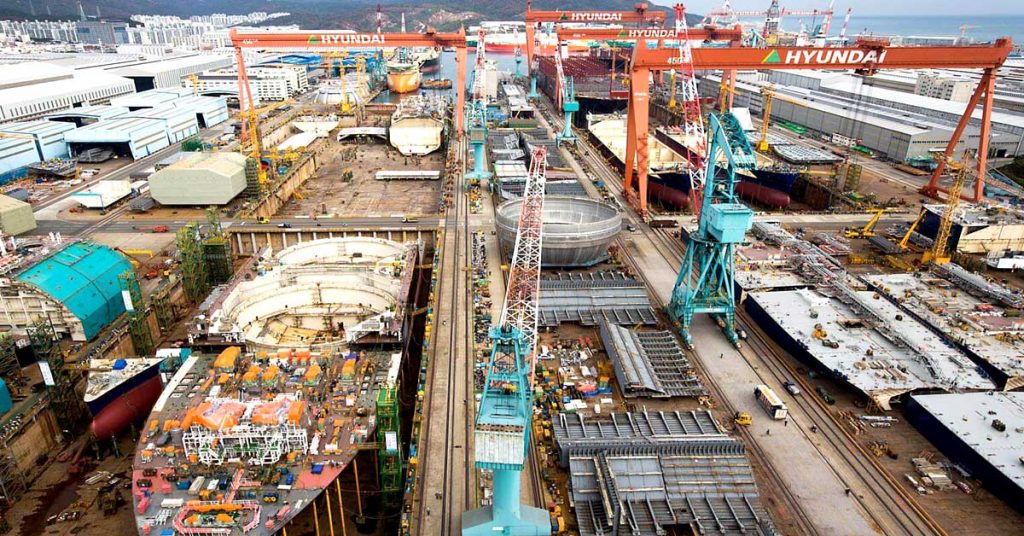Photo Credit: subicbaynews.net
SOUTH Korea’s ship builder Hanjin Heavy Industries and Construction Co. Philippines Inc. on Tuesday filed for corporate rehabilitation at the Olongapo Regional Trial Court, seeking protection from its creditors.
Ahead of the submission of the rehabilitation proposal in the local courts, its mother company, Hanjin Heavy in South Korea, had disclosed to Korean regulators the filing of the case in the Philippines, according to a report by Yonhap news agency in the Korea Herald.
The shipyard operation is known to be struggling to pay hundreds of millions of dollars in loans to some of the Philippines’s leading banks.
Company lawyers in Olongapo City declined to give details of the case but they brought in 10 blue boxes that appeared to contain documents of the case as they entered the court’s premises at about 4:20 p.m. of Tuesday. Court officials declined interviews.
The local Hanjin operations had laid off some 7,000 workers in December, and sources said it plans to fire 3,000 more in the coming months, and retain some 300 workers that will maintain its factory located in Redondo Peninsula, in Subic Bay in Zambales.
In November it delivered two units of 114K tanker to Singapore-based Eastern Pacific Shipping, according to the company’s web site.
“Its ship owners are also expecting two more tankers of the same kind to be delivered on the first quarter of 2019. And with the positive business momentum of HHIC Phil and Eastern Pacific shipping, the latter have ordered two more tanker vessels that is set to start its construction on the second quarter of 2019,” the company said then.
Since it started its operations in 2004, it had already completed 123 vessels and there were six more orders, but that could also be in danger of being canceled out.
Since June last year, the once mighty Korean firm—that at one point propelled the Philippines to become the fifth top ship builder in the world—had already sounded off that it is selling its Philippine assets valued at about $1.64 billion.
It has been racking up debt since 2016, when the mother firm also started disposing of noncore assets. Hanjin Heavy in Korea had, since 2016, been reported to be selling some of its noncore assets as it struggled to meet obligations to creditors. The Yonhap report said that, so far, the mother firm had complied with 65 percent of the 2.1-trillion-won ($1.86 billion) restructuring scheme proposed by creditors.
According to the earlier plan in mid-2018 that did not push through, the Korean firm will sell its 85-percent stake in the Subic Bay facility for about $894 million and will retain the rest.
Davao-based businessman Dennis Uy was once short-listed for the purchase but later on backed out of the deal.
Subic Bay Metropolitan Authority (SBMA) Chairman Wilma T. Eisma said she was “saddened” to learn that Hanjin Philippines is facing serious financial trouble.
“The bottom line is that the company said it does not have enough cash to repay its loans, and that it cannot continue with its operations under these circumstances,” she said.
Usual incentives
Contacted by the BusinessMirror, Trade Secretary Ramon M. Lopez confirmed that Hanjin Heavy Industries and Construction Philippines had once enjoyed the usual income tax holiday from the Board of Investments (BOI). The ITH is usually enjoyed for up to six years of a locator’s existence. Hanjin shipyard was established in 2004.
However, Lopez is unsure if Hanjin is still receiving any incentive from the SBMA, which is overseeing its business activity in the free port area. Firms in economic zones and free ports, such as Hanjin, are usually granted tax perks, such as the 5-percent tax on gross income earned (GIE) in lieu of all local and national taxes.
The Duterte administration’s second tax-reform program seeks to rationalize these incentives, and overhaul the entire menu of tax perks offered to locators such as Hanjin.
“Hanjin is registered with [the] BOI and [the] SBMA. It is done with ITH with [the] BOI, but might still be enjoying something from [the] SBMA,” Lopez told the BusinessMirror.
Biggest investor, employer
Hanjin Subic is the biggest investor at the former sprawling US naval base transformed into a free port after the Americans left in 1991, and now managed by the SBMA.
In past years, Hanjin-Subic had been rocked by allegations of lax compliance with labor safety standards, prompting a Senate committee inquiry into workplace conditions at the shipyard, which sits across from the main Subic commercial area, facing Redondo Bay.
HHICC-Phil’s reported multiple workplace accidents led to several casualties since 2009.
Just last year, DOLE-Region 3 Director Zenaida Campita issued another work-stoppage order against the company after another accident killed one of its employees and injured three others.
Source: businessmirror.com.ph
